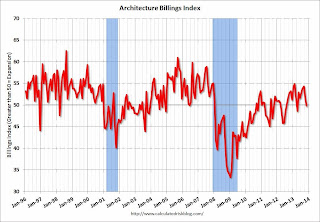by Calculated Risk on 12/18/2013 10:00:00 AM
Wednesday, December 18, 2013
AIA: "Slight Contraction for Architecture Billings Index" in November
Note: This index is a leading indicator primarily for new Commercial Real Estate (CRE) investment.
From AIA: Slight Contraction for Architecture Billings Index
After six months of steadily increasing demand for design services, the Architecture Billings Index (ABI) paused in November. As a leading economic indicator of construction activity, the ABI reflects the approximate nine to twelve month lead time between architecture billings and construction spending. The American Institute of Architects (AIA) reported the November ABI score was 49.8, down from a mark of 51.6 in October. This score reflects a slight decrease in design services (any score above 50 indicates an increase in billings). The new projects inquiry index was 57.8, down from the reading of 61.5 the previous month.
“Architecture firms continue to report widely varying views of business conditions across the country. This slight dip is likely just a minor, and hopefully temporary, lull in the progress of current design projects,” said AIA Chief Economist Kermit Baker, Hon. AIA, PhD. “But there is a continued uneasiness in the marketplace as businesses attempt to determine the future direction of demand for commercial, industrial, and institutional buildings.”
emphasis added
 Click on graph for larger image.
Click on graph for larger image.This graph shows the Architecture Billings Index since 1996. The index was at 49.8 in November, down from 51.6. Anything below 50 indicates contraction in demand for architects' services. This index has indicated expansion in 14 of the last 16 months.
Note: This includes commercial and industrial facilities like hotels and office buildings, multi-family residential, as well as schools, hospitals and other institutions.
According to the AIA, there is an "approximate nine to twelve month lag time between architecture billings and construction spending" on non-residential construction. This index is not as strong as during the '90s - or during the bubble years of 2004 through 2006 - but the readings this year suggest some increase in CRE investment in 2014.


